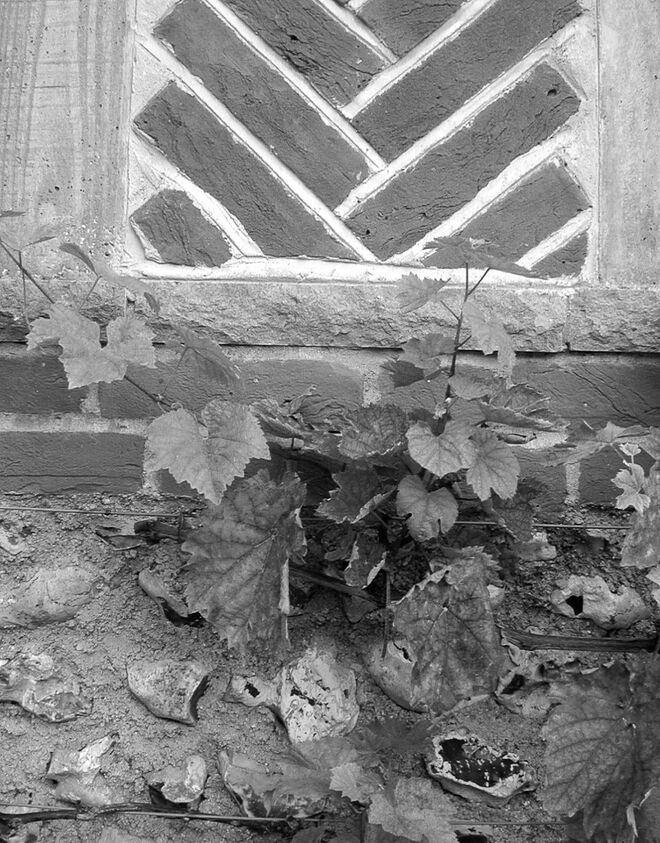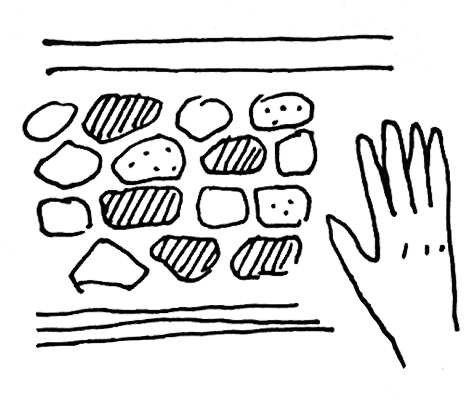12.3. Friendly Surfaces
Aus Pattern Language Wiki
One of the components of Biophilic Urbanism is concerned with how attractive we perceive surfaces to be when we are near them. Then, Human-Scale Detail can help to define surfaces that we can connect with. Lastly, Complex Materials offer far more visual interest, hence emotional engagement, than dull industrial materials.
Problem-statement: The physical characteristics of surfaces affect us in a profound yet subconscious manner. Neuroscience, rather than antiquated and unprovable architectural creeds, should decide on their qualities.
Discussion: The surfaces of buildings we are exposed to play a determining role in how we experience the environment. There exist ‘friendly’, ‘neutral’, and ‘hostile’ surfaces as judged by our neuro-physiological responses to them. Experiments determine why we feel attracted to touch a particular surface, and are repelled by another. Continuing to apply unprovable architectural diktats on how surfaces have to be finished and shaped ignores this information.
Industrial-minimalist surroundings don’t ‘belong’ to us, because their geometry and surfaces are often contrary to what our sensory system instinctively seeks. But even if we find surfaces aggressive and hostile, we are legally prohibited from modifying them. Yet adapting a surface to human sensibilities (through paint, or owner-created ornament) is the easiest and cheapest way of significantly improving our environment. In the past, people from the most impoverished settings, to those belonging to a social class with power and wealth, injected delight, personal meaning, and serenity into their living spaces. The tool was to create tactile surfaces smooth to the touch, framed by ornament, using emotionally attractive color, etc. Those qualities were eliminated in turning towards early 20th century industrial minimalism.
Designing by satisfying the human senses makes a building more sustainable. A building that is loved by its users because they feel it to be ‘friendly’ will be taken care of and survive normal wear and tear. A blank wall can be interesting if it shows visual texture, but not if that makes it hostile to touch. For example, using smooth slabs of natural materials such as colored marble and travertine creates an intimate bonding with the user up close. (A famous example is the Barcelona Pavilion by Ludwig Mies van der Rohe, 1929). This effect can be explained by the new patterns Biophilic Urbanism and Fractal Pattern, from the fossil microorganisms that comprise the rock. In contradistinction, both tactile and visual senses perceive brutalist concrete as hostile, especially if it maintains the texture of the casting forms. Users could scrape their skin from rubbing against it. Its typical gray color triggers subconscious associations with death (decomposing bodies, putrefied food) and pathologies of the eye-brain system that reduce our vision to grayscale (cerebral achromatopsia from a stroke). Smooth concrete allows one to touch it, but this does not change its depressing color. Visually attractive materials when used outside (brick, roughly-finished stone) become tactually hostile when used in interiors.
The ubiquitous use of plate glass curtain walls removes us from our millennial connection to surfaces, and is neutral. Being transparent, a large percentage of the world’s built surfaces simply don’t register in our mind and body. Physical material, if it follows some traditional guidelines, can establish a positive connection with the user. We are aware of the moral, philosophical, and political arguments that supported erecting exclusively hostile surfaces for decades. Even though generations of architects treated those as articles of faith, we do not find any scientific merit in them.
Therefore:
Shape wall surfaces to engage us on a visceral level so that we feel at home in our environment. Liberate architecture to once again include attractive colors, and shape surfaces that we can experience up close so they are inviting to touch. Beware of an overwhelming reliance on the psychologically neutral glass curtain wall.
Use Ornament to complement a wall surface that has been made friendly, especially where it connects to other surfaces.…
¹ A good discussion of the findings on the aesthetics of surfaces (and other aspects of the built environment is in Cold, B., Kolstad. A, and Larssaether, S. (2001). Aesthetics, Well-Being and Health: Abstracts on theoretical and empirical research within environmental aesthetics. Oslo: Norsk Form (The Foundation for Design and Architecture in Norway).
Mehaffy, M. et al. (2020). FRIENDLY SURFACES (pattern). In A New Pattern Language for Growing Regions. The Dalles: Sustasis Press. Available at https://pattern-language.wiki/.../Friendly_Surfaces
SECTION I:
PATTERNS OF SCALE
1. REGIONAL PATTERNS
Define the large-scale spatial organization…
1.4. 400M THROUGH STREET NETWORK
2. URBAN PATTERNS
Establish essential urban characteristics…
3. STREET PATTERNS
Identify and allocate street types…
4. NEIGHBORHOOD PATTERNS
Define neighborhood-scale elements…
5. SPECIAL USE PATTERNS
Integrate unique urban elements with care…
6. PUBLIC SPACE PATTERNS
Establish the character of the crucial public realm…
7. BLOCK AND PLOT PATTERNS
Lay out the detailed structure of property lines…
8. STREETSCAPE PATTERNS
Configure the street as a welcoming place…
9. BUILDING PATTERNS
Lay out appropriate urban buildings…
10. BUILDING EDGE PATTERNS
Create interior and exterior connectivity…
10.1. INDOOR-OUTDOOR AMBIGUITY
SECTION II:
PATTERNS OF MULTIPLE SCALE
11. GEOMETRIC PATTERNS
Build in coherent geometries at all scales…
11.2. SMALL GROUPS OF ELEMENTS
12. AFFORDANCE PATTERNS
Build in user capacity to shape the environment…
13. RETROFIT PATTERNS
Revitalize and improve existing urban assets …
14. INFORMAL GROWTH PATTERNS
Accommodate “bottom-up” urban growth…
15. CONSTRUCTION PATTERNS
Use the building process to enrich the result…
SECTION III:
PATTERNS OF PROCESS
16. IMPLEMENTATION TOOL PATTERNS
Use tools to achieve successful results…
16.2. ENTITLEMENT STREAMLINING
16.3. NEIGHBORHOOD PLANNING CENTER
17. PROJECT ECONOMICS PATTERNS
Create flows of money that support urban quality…
17.4. ECONOMIES OF PLACE AND DIFFERENTIATION
18. PLACE GOVERNANCE PATTERNS
Processes for making and managing places…
18.3. PUBLIC-PRIVATE PLACE MANAGEMENT
19. AFFORDABILITY PATTERNS
Build in affordability for all incomes…
19.1. INTEGRATED AFFORDABILITY
20. NEW TECHNOLOGY PATTERNS
Integrate new systems without damaging old ones…
20.2. RESPONSIVE TRANSPORTATION NETWORK COMPANY

